

AIATSIS. Virtual Dreaming: Everyday Life of the Darug People. Dharug Language for Primary School Students (incl. language intro videos) An important aspect of language maintenance and revival is familiarising more people, especially children, with the language in question.

To this end, it is valuable to introduce schoolchildren to the Aboriginal language(s) of the area where they live, if the Aboriginal community is happy for this knowledge to be shared. In videos on the pages hyperlinked below, Jacinta Tobin, from the Dharug nation, gives children a brief introduction to some words and phrases from the Dharug or Sydney language. These are particularly relevant for school students in the Sydney area who are learning about their local history and culture. Each video clip is only 45-60 seconds long and includes teacher’s notes with relevant Australian Curriculum outcomes for English (Foundation and Year 3) and Geography (Year 6). Whether or not the students belong to the Dharug community, these video clips will give them an awareness of and appreciation for the language. Indigenous Languages. Aboriginal Uluru Dreamtime Story - Uluru (Ayers Rock) Australia.
For the Aboriginal people of Australia, Dreamtime represents the essence of their society, culture, traditions and spirituality.
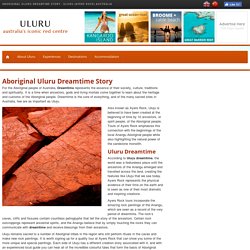
It is a time when ancestors, gods and living mortals come together to learn about the heritage and customs of the Aboriginal people. Dreamtime is the core of everything, and of the many sacred sites in Australia, few are as important as Uluru. Dust Echoes - ABC Education. Australians Together. Little Yarns - ABC Kids. Developed in collaboration with our Little Yarns First Language speakers, this collection offers meaningful ways to follow-up on each episode.
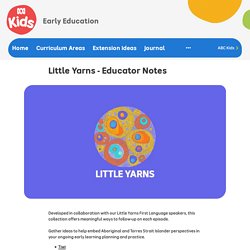
Gather ideas to help embed Aboriginal and Torres Strait Islander perspectives in your ongoing early learning planning and practice. About Little Yarns Australia is full of diverse Aboriginal and Torres Strait Islander nations. From Bunuba to Wiradjuri, Mabuiag to palawa, every mob has its own language and unique culture. Each episode of Little Yarns will take you on a journey to a different nation to learn a first word on Country. The Song of Bennelong and Pemulwuy. Popular Aboriginal Dreamtime Stories. Aboriginal Dreamtime stories speak of events from the time of creation.
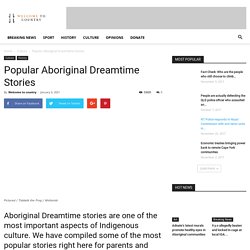
These stories have been passed on from one generation to the next for thousands of years. Dreamtime stories are also preserved in our songs and dances. These stories give us understanding of the past and have helped us survive through the laws and morals that lay within these stories. If you’re a teacher or student looking for more educational articles, make sure to bookmark/save our Education Series link here. Creation Stories - Bunjilaka. Tiddalik One of Australia’s best known Creation Stories Tiddalik is a small mischievous and very thirsty frog who appears in one of Australia’s best known Creation Stories.

ABC Online Indigenous - Interactive Map. Eora - Mapping Aboriginal Sydney 1770-1850. This is a story of the Eora, created through a close and innovative interrogation of the European records of early colonisation. Eora - Intro It is customary for some Indigenous communities not to mention names or reproduce images associated with the recently deceased. Members of these communities are respectfully advised that a number of people mentioned in writing or depicted in image in the following pages have passed away.
Understanding Songlines: A 360 experience with Rhoda Roberts AO. Songlines at Vivid LIVE 2016 - Sydney Opera House. What are songlines? National Museum of Australia. A History of Aboriginal Sydney. There is good evidence of a high Aboriginal population density at contact.
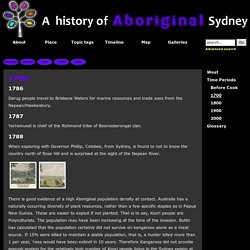
Australia has a naturally occurring diversity of plant resources, rather than a few specific staples as in Papua New Guinea. These are easier to exploit if not planted. That is to say, Koori people are Polyculturists. First Peoples - Bunjilaka (Victoria) Aboriginal History for Kids - The First Australians. Australia's Aboriginal History ('Aboriginal Australia') 1788 - Before European Settlement.
Aboriginal Land From at least 60,000 B.C. the area that was to become New South Wales was inhabited entirely by indigenous Aboriginal and Torres Strait Islander peoples with traditional social, legal organisation and land rights.
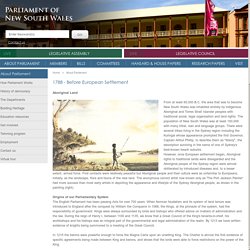
The population of New South Wales was at least 100,000 with many tribal, clan and language groups. First Nation peoples: Who We Are (Primary) (YouTube playlist) 'Yarning circle' teaches students to respect the land they live on - ABC News. Yarning Circles. Australian Sacred Sites. Australian Sacred Sites Aboriginal sacred sites are areas or places in Australia of significant Aboriginal Australian meaning within the animist context of the localised indigenous belief system.
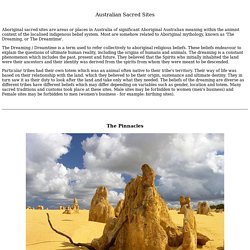
Most are somehow related to Aboriginal mythology, known as 'The Dreaming, or The Dreamtime'. The Dreaming / Dreamtime is a term used to refer collectively to aboriginal religious beliefs. These beliefs endeavour to explain the questions of ultimate human reality, including the origins of humans and animals. Importance of land - National Geographic [Video] The Land Owns Us. The many uses of indigenous plants - Science (4,7) 00:00:00:00Text on screen - 'Viewer Advice.

Aboriginal and Torres Strait Islander viewers are advised that the following media resource may contain images and voices of people who have died.' A group of Indigenous people distribute and plant native plants in Australian coastal bushland. WilderQuest. Mabo/...The doctrine of terra nullius... ...The doctrine of terra nullius... 'Prior to 1992 and the Mabo decision, Murray Island and the Aboriginal rights in Murray Island were the same as the rest of Australia.

The law, when we started this case in 1982, was that no Aboriginal or Islander communities enjoyed traditional rights to land. This was the doctrine of terra nullius, which had been accepted by the courts as existing since 1788, through the whole of Australia. Indigenous Weather Knowledge - Bureau of Meteorology. Aboriginal and Torres Strait Islander people have developed an intricate understanding of the environment over many thousands of years. Artist: Laurie Nilsen The artwork used in the design of this website represents the relationships between seasonal, meteorological and astronomical changes - and how the Mandandanji people read these changes to inform life on country.
About the Indigenous Weather Knowledge website Learn more about the Indigenous Weather Knowledge (IWK) website and the Bureau of Meteorology's commitment to strengthening respectful and collaborative relationships with Aboriginal and Torres Strait Islander people. About the Indigenous seasons calendars. The Different Seasons in Australia's Indigenous Cultures - Behind the News. Aboriginal Astronomy - Behind the News. A real history of Aboriginal Australians, the first agriculturalists - TEDx. Bush Tucker Garden - Behind the News. Family and kinship. The Story from the Shore: first contact from an Aboriginal perspective. I had been asked to collaborate with four different communities along the east coast — Narooma, Kamay, Waalumbaal Birri and Possession Island — to create a 10–12-minute piece of cinema. While my practice is built on co-creation, this was the largest engagement process I had ever been asked to do. The Museum was empowering communities to tell, often for the first time, the story of the Endeavour voyage from an Aboriginal perspective.
This is not only important for them, but also hugely significant for the whole nation. From the scripting to the casting, the communities we worked with were intensively involved, making it a culturally rich experience for everyone engaged on the film. Living with the locals: Six extraordinary first contact stories of friendship and survival. Not all stories of first contact between European settlers and Indigenous Australians were fraught with violence and mistrust. Whether lost or escaped, marooned or shipwrecked, exiled or on the run, many Europeans found themselves living with the locals, immersed in their cultures and languages. Some of these relationships were lasting and deep; many were compassionate and peaceful during a time of incredible upheaval. These men and women had a rare opportunity that few would ever experience: to get a true and rich inside view of Aboriginal cultural life pre-contact.
As a husband-and-wife team — coming from an Indigenous and non-Indigenous perspective — with a shared passion for the history of Australia's first peoples, we pieced together these incredible stories of disaster, survival, loss, faith and friendship. Six tales of survival from the history books. History: Colonisation : Working with Indigenous Australians.
Initial invasion and colonisation (1788 to 1890) The arrival of Lieutenant James Cook, and then Arthur Phillip in 1788, marked the beginning of ‘white settlement’. From 1788, Australia was treated by the British as a colony of settlement, not of conquest. Aboriginal land was taken over by British colonists on the premise that the land belonged to no-one (‘terra nullius’). The history of Aboriginal dispossession is central to understanding contemporary Aboriginal and non-Aboriginal relations. Traditional Knowledge: cool burning. Backburning, Caring for Country - Behind the News. Artefacts - Search Museums Victoria's collections. What Is National Sorry Day? - Clickview. What can we learn from indigenous Australians and their 60,000 years caring for country? The case to recognise Indigenous knowledge as science - TEDx. Ask us anything: Aboriginal and Torres Strait Islander people.